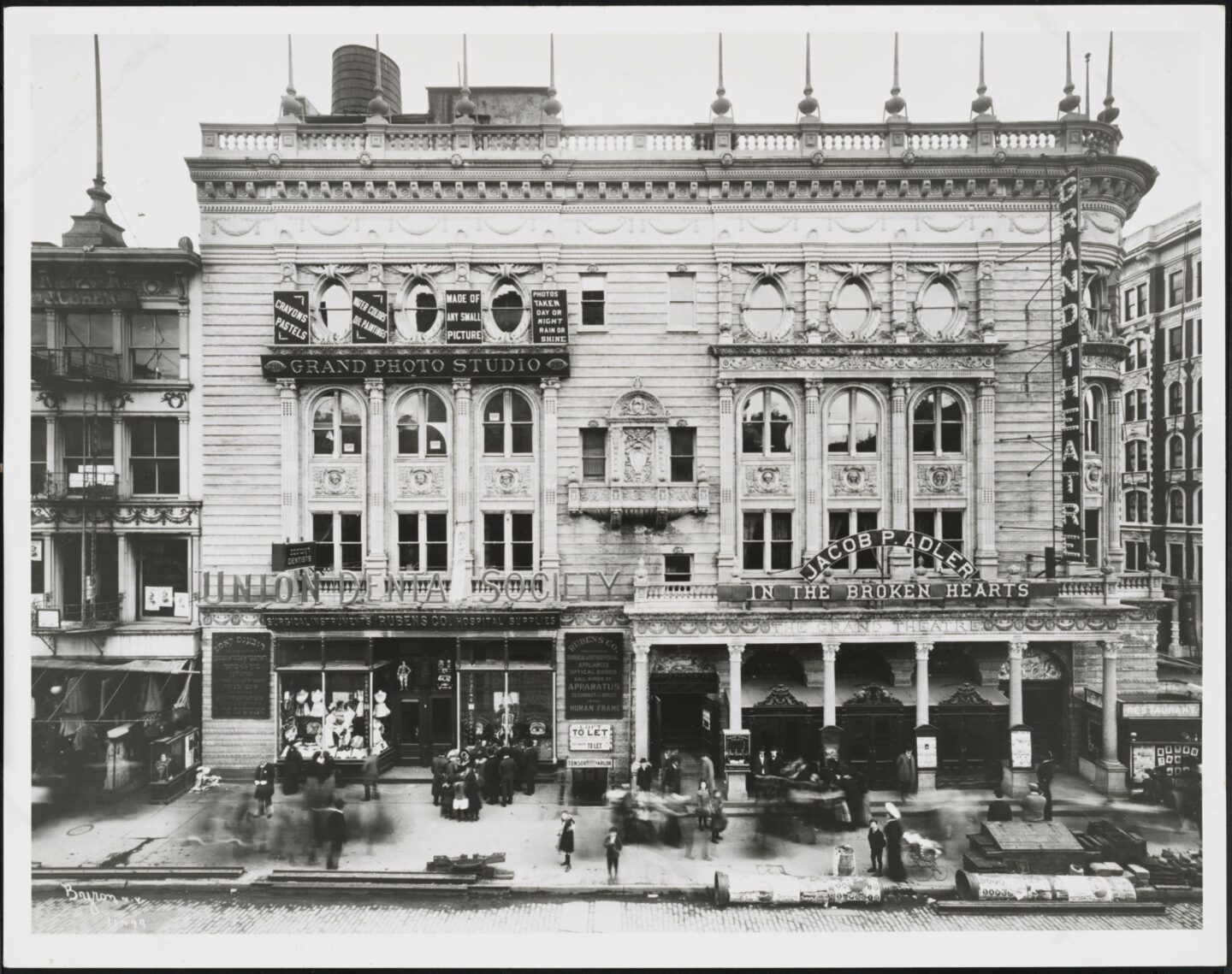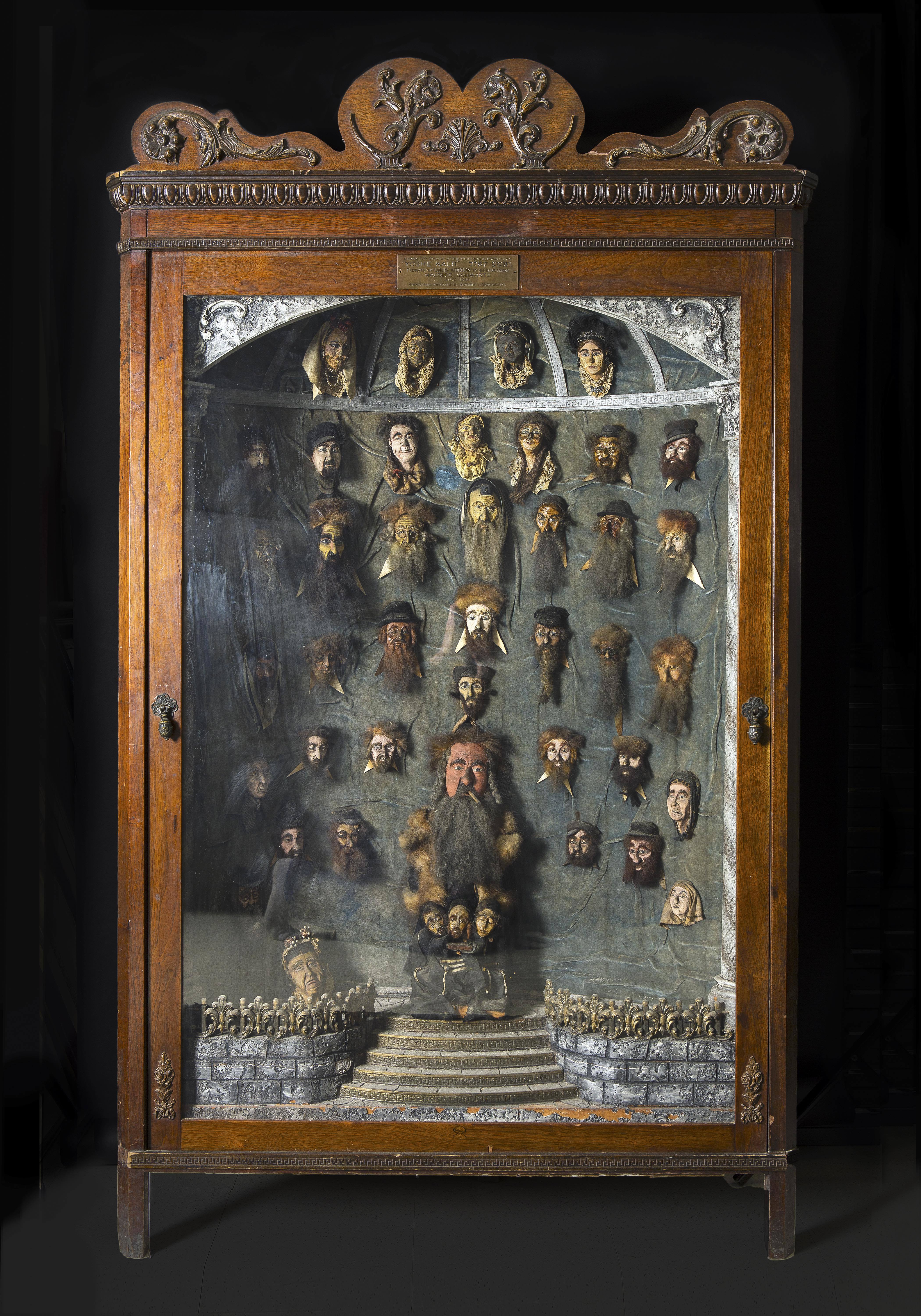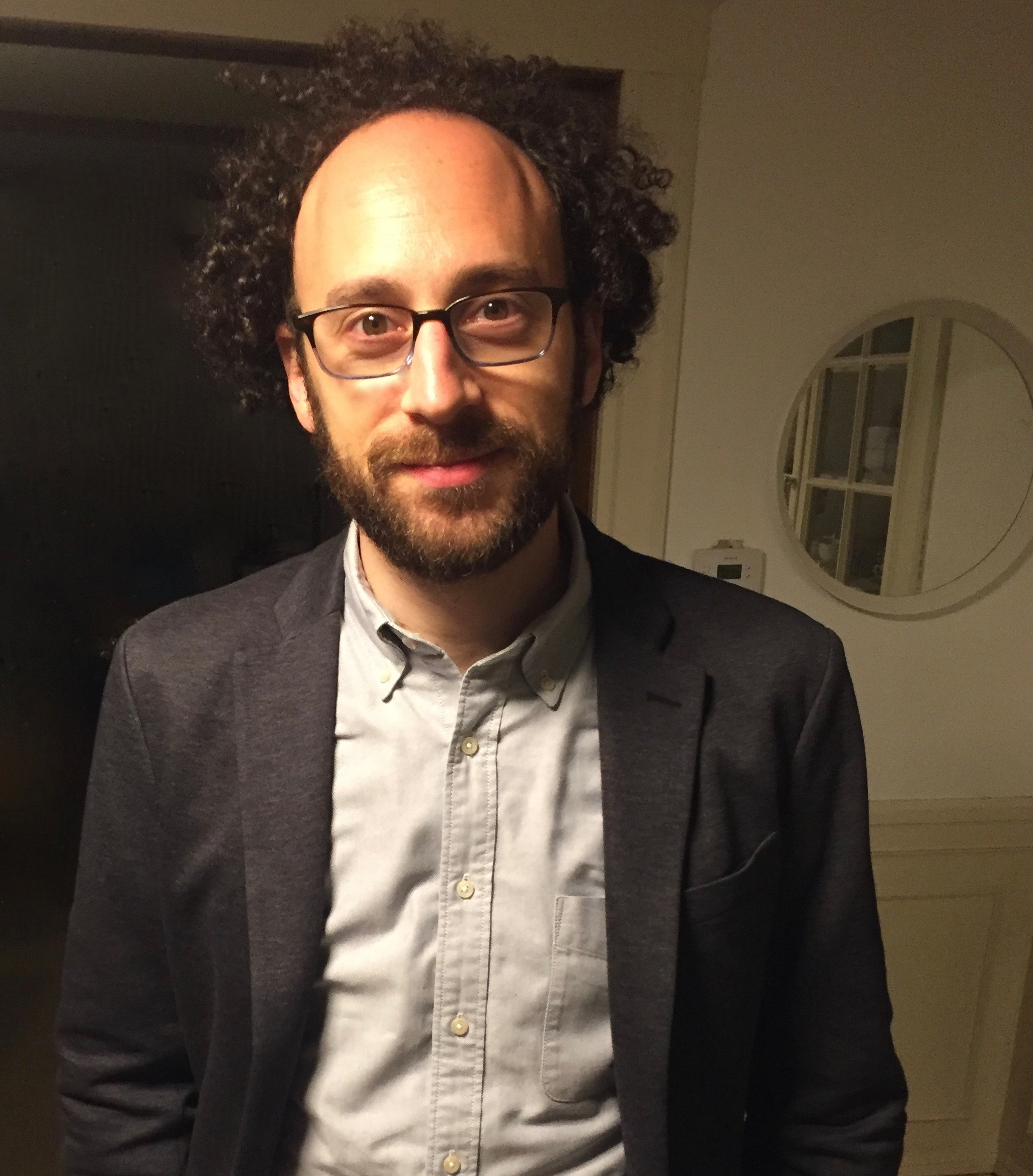Mar 29, 2016

Grand Theatre presents Jacob P. Adler in The Broken Hearts, c. 1903. Photo: Byron Company. Museum of the City of New York, The J. Clarence Davies Collection, 1929.29.100.811
The exhibition “New York’s Yiddish Theater: From the Bowery to Broadway” recently opened at the Museum of the City of New York, curated by Edna Nahshon. The exhibition follows the history of Yiddish theater in New York, from its immigrant beginnings on the Lower East Side to its afterlives as one of the foundations of Broadway. In geveb editor Saul Noam Zaritt sat down for a conversation about Yiddish theater with assistant curator Stefanie Halpern, who happens to also be a member of In geveb’s editorial board.
SNZ: A bunch of institutions, including YIVO, have had this amazing material in their archives for a while. Why make an exhibition now?
SH: MCNY had a sizable Yiddish theater collection that was being processed and organized about four or five years ago. The museum likes to draw from its own collections for exhibitions and I think they realized there was an opportunity here to do something with this collection, in collaboration with other institutions, that hadn’t really ever been done before on such a large scale here. The museum is dedicated to telling the stories of New York’s dynamic and sometimes fraught history, and the Yiddish theater was a part of the changing social, cultural, and political scene of the city, producing plays that covered every big topic from women’s rights to Americanization to workers’ strikes to Nazism. I think many visitors are surprised to see how much of the subject matter still feels fresh and relevant today. And of course, Yiddish audiences were not immune to the cult of celebrity where fans hung on a star’s every move and fashion choice. Many made headlines more often for what was happening in their personal lives than for their acting abilities. Again, not so different than what goes on today.
While it’s true that many institutions across the country house great materials that relate to the Yiddish theater, there’s not a single repository that houses a comprehensive collection. So it’s an interesting problem when you really don’t know what’s out there or the condition that some of the objects and ephemera are in. We, as curators, didn’t feel satisfied until we had taken a peek behind every curtain. (That was supposed to be a joke, curtain, get it.) We spent about two years just searching for materials among MCNY’s holdings and in the collections of several other museums, personal collections, and archives, including YIVO, The New York Public Library, the Museum of Jewish Heritage, Hunter College, Southern Illinois University Carbondale, and more. We went through so many boxes of photos and scripts and playbills and set designs and costumes just to try to get a handle on the scope of what was available to us. I think this is one of the reasons that the exhibition is so important—it uncovers pieces that had been just stored away and forgotten. If nothing else, I think this really shows the importance of getting your hands dirty and doing real research that engages with the past.
The problem, of course, with finally getting an accounting of the thousands of objects and ephemera out there is finding value in each particular discovery. I felt that each box and folder contained an amazing revelation. It took some time to gain perspective. How do you wade through everything to tell a story, to accurately and effectively show the vibrancy of this institution? We tried to let the objects guide the narrative in an organic way, rather than construct a story and then fit objects into what we wanted to say. This made every choice a negotiation, as we tried to strike a balance between scholarly and aesthetic impulses—choosing only things that were important historically or culturally wouldn’t necessarily make for a visually appealing exhibit. And only choosing objects with visual appeal that we couldn’t identify wouldn’t have been intellectually honest.
SNZ: So how did you locate and choose those objects?
SH: Most memorably, I spent some time crawling around the basement and the hidden closets of the old Hebrew Actors Union building on East 7th Street uncovering some lost treasures. Most of the playhouses of early twentieth century New York have been torn down, so going into the bowels of that building really felt like stepping back in time for me. The walls are plastered with photographs of actors and stage productions, dusty but still as vibrant as I imagine they were fifty years ago. When we opened one box it smelled of cigars. It’s these little details that make you feel like this institution still has some life in it, even if the stage no longer exists.
SNZ: Let’s take a step into that vibrant world for a moment. The Yiddish theater of the late nineteenth and early twentieth century brought together a large diversity of Jews to see plays that ranged from highbrow art pieces to lowbrow shund. What drove the Yiddish stage to have such a broad range?
SH: I’ll start small by saying that the Yiddish theater was a commercial institution. That’s true of both the companies and theaters that put on comedies and operettas and melodramas and those devoted to staging straight dramas and literary plays. I think there were very few practitioners whose artistic ideology ran so deep that they wouldn’t pander to the crowds. Even Maurice Schwartz’s Yiddish Art Theater, devoted to performing Yiddish literary plays and translations and adaptations of the Western canon, was motivated by ticket sales. In this respect, the Yiddish theater in America was no different than Broadway.
I guess an actor like Jacob Ben-Ami, arguably one of the greatest Yiddish dramatic actors, is an exception to this rule. Ben-Ami performed with Maurice Schwartz’s company for a few seasons, but he and Schwartz had their differences, as all artists do. Ben-Ami thought that an art theater should be devoted to staging literary plays that offered an alternative to the commercial theater, and also was a proponent of a repertory style of acting with each member of the company taking turns playing the lead. But Maurice Schwartz, undoubtedly a superb manager and producer, was also a great actor, he thought the greatest, and he usually cast himself in the lead role. Ben-Ami found it suspect and against his artistic sensibilities that Schwartz seemed to care about profit as much as—if not more than—art. I think that a certain disillusionment pushed Ben-Ami onto the American stage pretty early on in his career. He makes his English-language debut in 1920, just a few years after his debut in Yiddish in America, with the Greenwich Village Theatre, part of the Little Theatre Movement. He also acted with the Provincetown Players and the Theatre Guild, and even performed in some of the first productions of Eugene O’Neill’s plays. Eventually, though, he became equally disillusioned with the little theaters, especially the Theatre Guild, where he began to feel that ticket sales rather than a dedication to art dictated production choices. This is part of the reason he moved back and forth between the Yiddish and English stages, and even created his own company on several occasions which were, of course, never particularly successful because it’s hard to pay the bills when that’s not your real concern.
SNZ: Aside from the question of money, what were the dominant concerns of Yiddish theater as it changed over the first half of the twentieth century? How did it answer the needs of the immigrant population or how did it shape their understanding of both the world they left, Eastern Europe, and the new world they had come to?
SH: There were so many facets to the Yiddish stage. Musicals and comedies were being staged alongside literary dramas and political plays. Realism in stage acting was as prevalent as heightened emotional melodrama, and avant-garde staging and set designs were employed alongside gaudy and lavish sets. A company like Artef was devoted to political theater and the art theaters matched theatrical wits with the Russian and European stages. Jacob Gordin’s plays were didactic as compared to Goldfaden’s musicals whose plot lines were sometimes held together by the thinnest of threads, but were still firmly within the realm of melodrama when compared to the literary plays of David Pinski or H. Leivick. Plays about a lost Eastern European past found favor as frequently as plays about a new American reality. The point is that at no time was the Yiddish theater only one thing.
That being said, Yiddish theaters physically moved with their audience. As Jews moved out of the Lower East Side, playhouses opened in Brooklyn, the Bronx, even Harlem. And later, as audiences Americanized and could choose between seeing a Yiddish play or going to Broadway, when the language barrier wasn’t forcing their hand, actors and directors needed to find different means to attract a crowd. Some of the most successful were those whose own experiences both onstage and off mirrored the lives of their audiences. For example, an actor like Molly Picon played to full houses until the end of her career, both in Yiddish and in English. Her Yiddish musicals were basically different versions of the same play—Molly’s character was put in the position of having a mistaken or hidden identity. She would play a street urchin or a gamine, and after a series of hilarious missteps her character’s true identity would be revealed, allowing her to marry her love interest. Nobody could resist seeing a wedding on stage—love and Jewish continuity, what more could an audience ask for? When she acted in English, Molly always played the Jewish mother, a warm and inviting character that older audience members could identify with and younger viewers felt was part of their family.
SNZ: I always find this crossover between Yiddish and English audiences so fascinating. Even though Yiddish theater was aimed primarily at an immigrant Jewish audience, it soon became a central New York institution; Yiddish-language plays were reviewed in the New York Times! But let’s get back to the exhibition. What’s one of your favorite objects on display?
SH: There are so many it’s hard to name only one. One of the most unique is a wooden vitrine with clay heads of all the characters from Maurice Schwartz’s Yiddish Art Theater production of Yoshe Kalb—adapted from the novel by I.J. Singer. The heads were made in 1933 by Morris Strassberg, an artist and sculptor who was also member of the Yiddish Art Theater. The heads are grotesque and they feel like they might come to life at any moment. They’re also important because they give you an idea of how each of the forty-some characters in the production were outfitted with costumes and makeup. This piece is also pretty neat because it used to be on display in the entrance of the old YIVO building on 86th Street.
We’ve also got one of Barbra Streisand’s costumes from Funny Girl—from the scene where Nicky Arnstein seduces Fanny Brice. Fanny Brice was one of those performers who used Yiddishisms and a Yiddish inflection in her performances. And Barbra Streisand is notable because she was very public about refusing to get a nose job when it was all the rage with Jewish women to do so. There’s a great Al Hirschfeld caricature hanging next to the costume where Barbra Streisand is looking into the mirror, reminiscent of the opening “Hello, gorgeous” scene in Funny Girl. But in Hirschfeld’s depiction Streisand sees Fanny Brice’s reflection staring back at her. It’s a great commentary on how actors come to physically embody their subjects and also on how past and present reflect one another. (And honestly, besides all of that, I just really love Funny Girl.)
SNZ: What are some of your favorite stories that the exhibition tells?
SH: The Yiddish theater had some unlikely fans. We’ve got a few photographs with some of the most notable personalities of the twentieth century posing with their Yiddish theater favorites. Both Charlie Chaplin and Albert Einstein were great fans of Maurice Schwartz’s Yiddish Art Theater and posed with the cast of his productions for photos. Albert Einstein was particularly fond of the production of Yoshe Kalb. He wrote a really heartfelt letter to Maurice Schwartz in 1933 praising his work. And we’ve got a great photograph of Frank Sinatra and his agent looking at a poster of Menashe Skulnik, just peering up at him with big grins. These photos are fun to look at—stars with their stars—but they’re also indicative of the scope of the Yiddish theater audience. It didn’t only appeal to an ethnic niche.
There are many reasons why the Yiddish theater was appealing to non-Yiddish speaking audiences. One of the reasons lies in the popularity of slumming, which is interesting but not the focus of the exhibition. But there were also artistic and cultural reasons for visiting the Yiddish theater. The Yiddish stage was often looked at as being on the cutting edge of performance practice. For example, whereas the melodramatic style of acting dominated the American English language theater, the Yiddish theater was already employing a more emotional and realistic style of acting and playwriting. The Yiddish art theaters—Maurice Schwartz’s theater heading the pack—were really in line with the acting and set designing techniques of Europe and Russia. Many of these European design techniques were first seen in America on the Yiddish stage, via the work of Boris Aronson, who would go on to design some of Broadway’s most iconic shows (like Fiddler).
As far as telling the story of the Yiddish theater, there’s no avoiding the familiar, well-worn names and plays, and we certainly hit on some of the greats in the exhibition like Jacob P. Adler, Boris Thomashesfky, and Molly Picon. But we also tell the stories of some now lesser-known actors and practitioners. For instance we have a whole section on Mae Simon, a Yiddish vaudeville star. We knew we wanted to talk about the vaudeville stage, which ran parallel to the so-called legitimate stage, but we didn’t know how we would do that when so few objects existed. We were lucky that Leo Greenbaum, one of the archivists from YIVO, has a penchant for saving interesting collections from the basements of grandmas everywhere. He’s really to thank for the Mae Simon collection. We found in the collection, which has recently been processed and catalogued, a pair of red satin dancing shoes, a few souvenir pins, a makeup kit, feathers worn in the hair, a cigar holder, a photo of Mae in a man’s white suit and fedora smoking a cigar, and a huge poster advertising Mae Simon as a vaudeville star. It was a perfect mix of Mae Simon’s private life and stage persona, and we knew that we could tell the vaudeville story through these objects.
SNZ: Why is this material still relevant today? How would you describe the connection between Yiddish Broadway and today’s Broadway?
SH: Many of the techniques that the Yiddish stage introduced to the American theater have become givens. We don’t have crossover actors anymore and there’s very little Yiddish cultural output for the professional stage, so in order to trace the lasting influence of the Yiddish theater on the American stage today, we really tried to look at how the Yiddish theater became part of the cultural imagination of America. We ended the exhibition with some contemporary-ish English language adaptations of Yiddish plays. To name just a few, we’ve got the set model for Café Crown, originally written in 1942 by Hy Kraft and then staged twice more in 1964 and 1988. The play is set in a Yiddish restaurant modeled after the famed Café Royal, a favorite haunt of the Yiddish theater crowd and it gathers onstage proxies for some of the Yiddish stage’s greatest and most well-known stars including Jacob Adler, his wife Sarah, and his daughter, Stella Adler. The play appropriated the space of the Yiddish theater and reconstituted it on the Broadway stage in a very sentimental and nostalgic way, sort of bringing to life—but also mourning—this lost world.
We’ve also got some production photos from Paddy Chayefsky’s The Tenth Man, a modern day telling of Ansky’s The Dybbuk, except Chayefsky replaces the shtibl of Eastern Europe with a nearly-defunct synagogue in a New York suburb. A group of old suburban Jewish men attempt to exorcise a dybbuk from a young, assimilated woman. One of the main takeaways here is that two worlds collide on the Broadway stage—the old and the new in more ways than one—and the audience sees a reflection of themselves in the characters: second and third generation American Jews struggling with a nearly foreign cultural and religious past.
I think many people, especially Jewish New Yorkers, feel a personal connection to the Yiddish theater. Some remember going to the theater as a kid, but even for those who never saw a professional Yiddish production, there’s something about the subject matter that reminds them of their parents or grandparents. And though this was purely a coincidence since the exhibition was underway well before the announcement was made that there would be a revival for the fiftieth anniversary of Fiddler, it is auspicious that the two coincide. The exhibition highlights several productions that harken back to a real and imagined Yiddish past, and Fiddler maybe more than any other production has come to represent—for better or for worse—a nostalgic longing for an old way of life.









